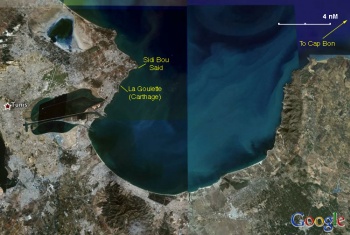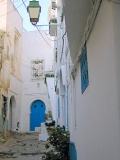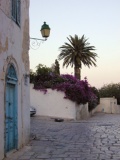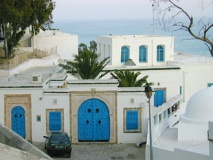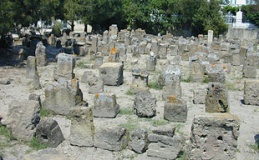Sidi Bou Said
From CruisersWiki
| Sidi Bou Said Port of Entry
| |
Sidi Bou Saïd is affluent suburb, some 20 km from Tunis (the capital of Tunisia), overlooking the the Bay of Tunis. It has been very popular with artists including Paul Klee and retains traditional 18th century architecture. The town is situated on steep cliff.
At the bottom of the cliff there is the Sidi Bou Said Marina where wealthy Tunisians keep their boats.
It is the only safe place for a visiting cruiser to leave a boat while visiting the city of Tunis and other sites.
Charts
See Tunisia.
Weather
See Tunisia.
Passages
See Aegean to West Mediterranean Passages.
Communication
- Marina - VHF channels 09 and 16 (they do not always respond)
Also see World Cruiser's Nets.
Warning: One difficulty with the approaching to the marina is its entrance. It gets silted and has to be dredged. You may have to wait for a dredge before entering or once inside you may be trapped until the entrance is cleared again.
Entrance
Sidi Bou Said is a port of entry to Tunisia. But, like all Tunisian ports, you must check-in even if you have already been cleared into the Tunisia.
For details about clearing see Tunisia.
Berthing
Go to the Sidi Bou Said Marina.
Marinas & Yacht Clubs
Anchorages
Yacht Repairs and Services
Marine Stores
None.
Repairs/Yards
There is a 15 ton travel-lift and the marina can do minor repairs.
Fuel, Water, & Electricity
Things to do Ashore
Tourism
The Village of Sidi Bou Saïd
The famous village of Sidi Bou Saïd is a 20-30 minutes walk from the marina, up the very steep path (350 steps) . Considering that this is one of the most celebrated and wealthy suburbs in Tunisia, there is an amazing amount of refuse along the path. The village of Sidi Bou Saïd is indeed charming although architecturally not very remarkable. What contributes to its charm are the elaborate doors, the iron grill work, and the vibrantly multi-colored bougainvilleas.
Tunis
Tunis is Tunisia's capital. The main avenue in Tunis is Avenue Habib Bourguiba referred to by the ever enthusiastic guide books as the Tunisian Champ Elysées. It is a very far cry from the original. The whole avenue is a dirty, dusty place lined by unremarkable concrete block buildings. This where the TGM (local train for Tunis) brings you from Sidi Bou Saïd.
But, the famous Bardo Museum more the makes up the visit. The taxi ride from the TGM terminal is long and hot through very heavy traffic with thick exhaust fumes. The museum is indeed a great museum. It is housed in a 19th century palace belonging to wealthy pirate-Bey. One marvels there after seeing one magnificent Roman mosaic after another. It is endless and very exiting. In addition to the mosaics, they have a very surprising exhibit from the shipwreck of a boat ferrying loot from Athens to Rome. There are two marvelous bronze statuettes of Hermaphroditus, two intact wooden beds, etc. They have a large the Punic (Carthaginian) exibit.
Another wondeful place to visit in Tunis is the Medina or Souk (market place) and wandered in the narrow streets for a while. Here there used to be the largest slave market in the Mediterranean where all the captives of the Barbary pirates were sold. One can feel the presence of untold human misery.
Carthage
Ancient Carthage is not too far from the marina. one can take a taxi to the Punic Harbor. It is very hard to see where and how the old Carthaginian ships were harbored. But in a small building, the Antiquarium there are several drawings and a model, which coupled with some imagination, allows one to visualize this most remarkable home port of the Carthaginian navy. Carthage was the major sea power of the western Mediterranean for several centuries until it was destroyed by the Romans. The ships were pulled out of water and housed in boat houses built around a circular lagoon.
From the Punic Harbor you can walk to the Salammbo Tophet where you see another, much more sinister, side of the ancient Carthaginians. Here is the burial ground, the Tophet, of the many children sacrificed to the goddess Tanit and the god Baal. It seems that these were only male children from 4 to 11 years old, the sons of prominent families. Their bodies were burned and their ashes were placed in small clay urns which were buried in the ground. The burial place was marked by a stone stele (a flat tombstone) embellished with the sacred signs of the god or goddess. There were hundreds of these stelae. A very intriguing culture about which we actually know very little. A thriller novel written by Elisabeth Craft gives an excellent evocation of this child sacrificing culture.
You can then walk to the TGM station and take the train for a few stops after which you take a long uphill walk to the Carthage Museum. It is situated on the top of Byrsa Hill from where one has a very good view of the whole Carthage region and the Bay of Tunis. The museum has a large collection of Punic objects, two sarcophagi of great detail, lots and lots of pottery and amphorae, and some remarkable glass miniature heads—very beautiful in full color. It also has a good Roman collection with more mosaics etc. In particular there are two lovely Roman statues of a charioteer and his wife—unearthed by Naomi Norman of the University of Georgia at her excavation of the cemetary near the hippodrome.
Dougga
Douga is World Heritage Roman archaelogical site the town of Teboursouk west of Tunis. It is a spectacular site. It is surrounded by rolling hills cultivated with acres and acres of wheat and small olive trees. One can spend several hours walking through the paved Roman roads to temples, baths, the Roman Theater, and a Punic Mausoleum. There are plenty of shady spots where one can stop to rest, read the guides, and admire the view.
Grocery & Supply Stores
- There is mini-market next to the marina
- Several stores in the vilage of Sidi Bou Saïd
- An outdoor market in the vilage of Sidi Bou Saïd
- A Carrefour supermarket. that has everything your heart may desire, but you need a car as it is about 5 km away.
Eateries
- Le Pirate restaurant, near the marina, was has a marvelous garden full of palm trees. Their specialties are mechouia salad (chopped grilled vegetables and tuna), grilled squid, and grilled dorado fish
- The Le Charguie restaurant up the hill on the village is very attractive and makes an excellent cous-cous (the Tunisian national dish)
- Also on the village, the Coté Sidi Chabaance café is a must be place. The view is marvelous and so is the watching of the locals sipping their tea and smoking their nargiles (water pipes). They do not serve any alcohol
Internet/WiFi
At the marina.
Laundry
In the vilage of Sidi Bou Saïd.
Motorbike & Car Rentals
Ask at the marina. office, the Capitanerie, they can help you make all the arrangements for a car rental.
Garbage Disposal
There are bins around the marina.
Transportation
- The Tunis-Carthage airport, with flights to France and other EU coutries, is 15 km away
- There are regular trains from the village of Sidi Bou Saïd to Carthage and Tunis
Friends
Contact details of "Cruiser's Friends" that can be contacted for local information or assistance.
Forums
List links to discussion threads on partnering forums. (see link for requirements)
Links
- Sidi Bou Saïd at the Wikipedia
- Sidi Bou Saïd
- Sidi Bou Said at the Wikipedia
- Ancient Carthage at the Wikipedia
- Sidi Bou Said at the Wikipedia
-
 Tunisia - North - Istioploos' Website
Tunisia - North - Istioploos' Website
References
See Tunisia.
Comments
We welcome users' contributions to the Wiki. Please click on Comments to view other users' comments, add your own personal experiences or recommend any changes to this page following your visit.
Verified by
Date of member's last visit to Sidi Bou Said and this page's details validated:
- June 2001 --Istioploos

| This is a usable page of the cruising guide. However, please contribute if you can to help it grow further. Click on Comments to add your personal notes on this page or to discuss its contents. Alternatively, if you feel confident to edit the page, click on the edit tab at the top and enter your changes directly. |
| |
|---|
|
Names: Lighthouse, Istioploos |
